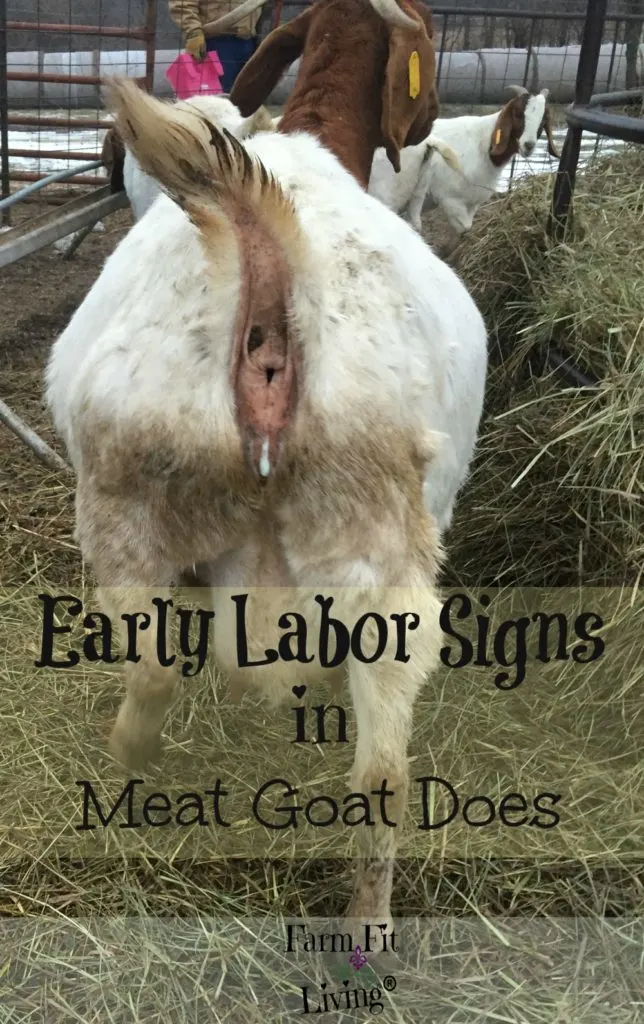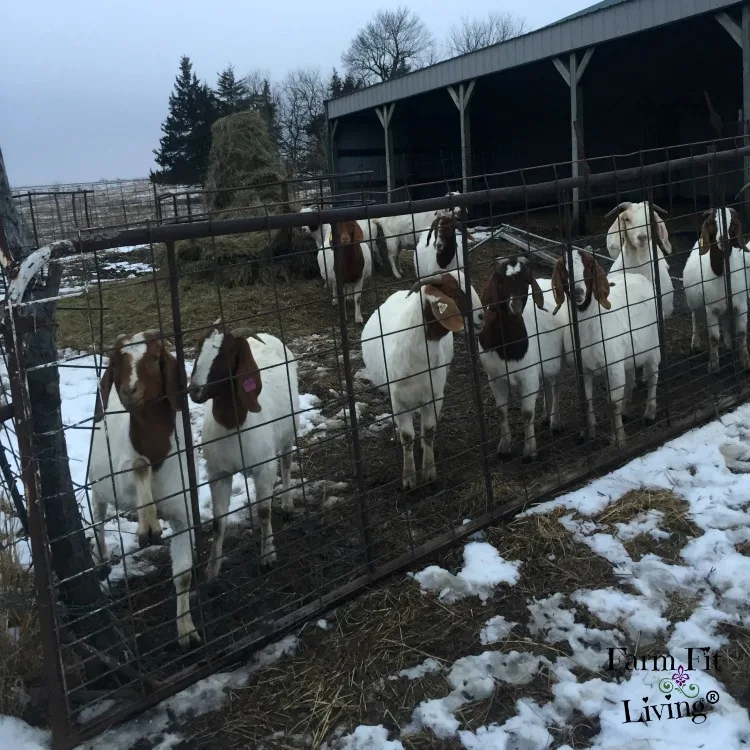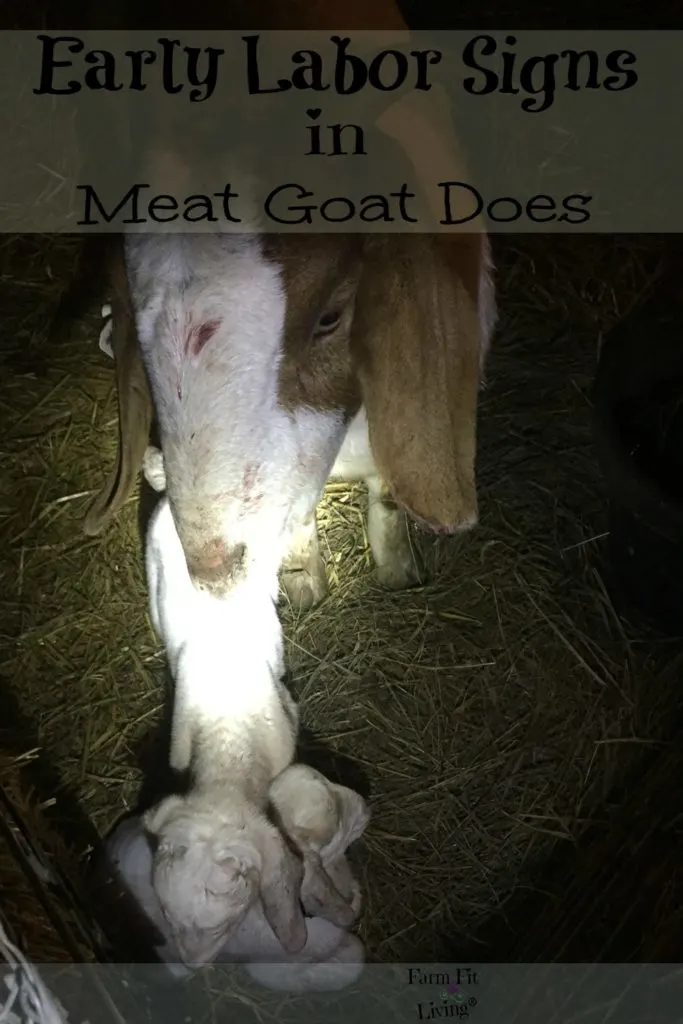Learn and know early labor signs before your doe is ready to kid.
When some people think of baby goat kids, they think of baby goats in pajamas or baby goats jumping on trampoline like many videos portray.
They don’t think about the messiness but beautiful process of how baby goats come into the world. And the process can go smoothly with less goat labor problems if the goat caretakers know the early labor signs and kidding signs.
Early labor signs are good for responsible meat goat producers to recognize for a couple of reasons:
– To be able to watch early labor signs and be sure the kid is positioned correctly and not stuck.
– For making sure the doe is in a comfortable, clean and safe environment for kidding and care of baby goats.
Listen to the podcast:
Even if you expect does to kid on their own, you need to watch them like a hawk. I have lots of does in my herd who prefer to kid on their own. However, I prefer to keep an eye on them and intervene IF NEEDED.
Because does should be able to kid on their own. In a perfect world, we would all be able to just walk out to the goat barn and see healthy happy newborn kids bouncing around. And happy healthy does caring for them.
But, sadly, things can still go wrong during labor. This is why I prefer to keep an eye on my does and encourage others to do the same. So, let’s talk about some early labor signs in a doe that is ready to kid.
This post contains Affiliate Links. This means if you click and buy, I might make a commission at no cost to you.
See my policy for more information
Early Labor Signs You’ll Notice
First of all, you’ll need to know that every single one of your does is different. Goats are not just goats. Not ever doe is the same. They have personalities and preferences that are different than one another.
So, their labor signs will be different as well. And whether you have a herd of 7 or 70, you’re still going to have to know what to look for.
Here are a few signs you can be watching for:
- A doe off by herself. Goats are social animals. If they are off by themselves, something might be wrong.
- Light to Moderate contractions. Like humans, you can measure a doe’s contractions on time and how difficult. Because does can have Braxton-Hicks contractions, too.
- Swelled udder. The udder should be as big and tight as a balloon. You’ll know it when you see it.
- Swelled vulva and clear discharge. Streaming is when there’s a long clear string of discharge. It looks like snot. It’s yucky, but a very good early labor sign to note.
- Loose Tail Ligaments
- Pawing the ground. She’s making a nest to prepare for kidding.
When you see these signs, you’ll know to watch the doe a little bit closer and get your kidding kit ready. You might be a little too ambitious at times. Here are some signs that you shouldn’t lose any sleep over.
Signs that are NOT NECESSARILY early labor signs
Then there will be times when you keep checking that doe over and over again thinking something will happen. And nothing every does. Until one morning, you go out to check and there’s the kid. Or three!
Think of the sleep you could have gained back if you would have just known.
Here are some signs that are not necessarily early labor signs.
- Prolapse. I once had a doe prolapse for a month before she finally gave birth to three healthy kids.
- Thick clear discharge the size of a large teardrop located in the vulva area (see above picture). It could just be the plug. You’ll need to consider other symptoms as well.
- A doe that has a leaky milk bag but it’s not full.
Don’t lose sleep over signs that aren’t true early labor signs. I typically check does every 4-6 hours. At night, I check at 10 p.m., go in to sleep, and get up at 4 a.m. to check for the morning. That’s if none of the does are showing early labor signs at 10 p.m.
If there is a doe showing early labor signs, I will stay up to check her every hour or so. If it’s cold out, I want to be sure to get her and the babies into a warmer place. I won’t typically move her until after she kids. Here’s why.
She’s Already Made Her Nest
I don’t want to disturb her and her natural progress. I believe she’s went to the work of making the perfect nest for babies. And I can move the family somewhere after words. This helps me in a couple of ways, too:
- It’s easier to move the doe since she follows the babies.
- Less mess if I wait until the final stage of labor is over.
- I don’t disturb her progress of labor. She won’t be stressed with the move into a new place.
She is comfortable where she is. So, when I find her giving early labor signs, I just watch and let her give birth to her kids. There’s no need to interrupt the process of labor.
What to Do When You Notice Early Labor Signs
I simply get ready for new babies to arrive:
- Grab the kidding kit.
- Make sure I have a bonding pen with fresh bedding ready.
- Find myself a comfy place to watch the magic happen. I have handy dandy blue nitrile gloves and lubricant ready in case I need to go in.
After knowing your doe is in early labor, you’ll need to understand the three stages of labor. Here they are:
3 Stages of Labor
As soon as you’re sure your doe is in labor, there are three stages to understand. The main thing to understand is that you are not going to help the situation until you see the second stage happening. So, just sit back, be patient and watch.
Let the doe do her job. She really doesn’t want your help anyway. I have found does to become nervous if they see me just standing their watching them. I try really hard to stay hidden when I watch the kidding process.
So, here’s a brief description of the three main stages of labor.
Discharge & Contractions – Stage 1
Some slight pushing may also occur during this first stage. But the doe is just hanging out. She’s moving the first kid into position towards the birth canal.
There is absolutely NO HURRY during this stage. She’s not actively pushing hard yet, so just let her take her sweet time. Here’s what it might look like:
- Laying down and standing up. Unable to be comfortable.
- She might be chewing her cud through the contractions.
- Early Labor Contractions increase intensity and are closer together.
This stage may last a while. Even a couple of days with some does. Unless they are actively pushing, there is no need to rush anything. All you’re calculating is contractions timing – nothing else because there’s no pushing happening.
You can check the birth canal by putting on a glove, lubing up and gently going in. You would feel a head or a tail. But if you feel nothing, just keep waiting until active labor begins.
Active Labor – Stage 2
This is where the magic happens. The 2nd stage of labor is active pushing. The doe will start pushing harder and you’ll start to see a water bag or placenta pushing out. If the placenta or water bag has broken, you’ll see a head or foot. If you see the tail, you’ll know it’s breech for sure.
Allow the doe to actively push by herself for an hour. If there’s no real progress being made, you’ll need to check her for problems. Here are some problems you might find:
- Kid is really big and stuck.
- Two kids in the canal at once.
- A head or a foot is back.
You can do some maneuvering yourself very gently. Find a leg to pull forward or push the baby back in to move the head. Be very careful when re positioning. You could easily tear the cervix or lining of the canal if not careful.
The hardest display I’ve ever encountered is two kids coming at once. They were all tangled up together and I could not figure out which one I was pulling. I finally blindly got them separated and pulled out. The babies didn’t make it but I know next time what to do in that situation.
If you do encounter a position you are unsure about, it might be best to call your mentor or vet if they are nearby. Focus on careful handling of the doe. Your doe’s health should be #1 during the kidding process so they can take care of their babies.
Expelling Placenta – Final Stage
This is the last but important stage of labor. The doe must expel and clean out her placenta and goat afterbirth completely. Do not pull it out. Read further.
IMPORTANT: You must let the doe clean on her own. Do not ever ever pull it out. If the doe is taking longer than a couple of days to clean, consult your veterinarian. Your vet can come over and clean the doe for you.
If you pull the placenta, you’re putting the doe at risk for illness and internal bleeding. The doe must use her own antibodies to heal on her own. She will use her own instincts to clean herself. She may also eat her placenta for nutrition (You can allow this or you can dispose of it).
I can’t stress the care of the doe enough. Your does are your breeding stock. They are your business. Yes, you sell the kids to make money, but you need does to make more babies. And with that said, you need your does to be healthy in order to care for their babies.
Bonding Time
Bonding after the babies are born is my favorite. I love watching the moms nuzzle and dry off their babies after they are born. It melts my heart.
I also understand this time needs to be JUST mom and babies. I do leave them alone for a while so they can bond together. In about an hour, I come back to make sure the kids are regulating their body temperature and nursing that thick, yummy colostrum.
If they haven’t nursed yet, I will usually try to help the kids find the teats. I’ve found that sometimes the kids aren’t hungry depending on what time they are born. Kids that are born in the afternoon or evening are hungrier than kids born in the morning. This is because I feed the does at night. So, if the doe hasn’t eaten for a while, the kids will be really hungry.
Therefore, they won’t be interested in eating. But, I still want to make sure they know where to find their milk. Healthy kids and healthy mamas who take care of their babies will greatly improve the success rate of your meat goat operation.

Improve Your Kidding Success Rate
In the many years I’ve raised goats, I’ve seen many different early labor signs. Each doe is just a little different. I’ve learned it’s important to know your does and how they act normally.
Then, you can recognize early labor signs a little bit easier. Plus, you’ll learn how your does change. You’ll learn what their udders should look like. If they go off by themselves or perform their birth in the comforts of their group.
Nevertheless, you want to be prepared. And that’s the main reason why you need to know early labor signs. Be prepared to improve your kidding success rate by being there to assist your does if they need you.
I mean, why wouldn’t you want to be? Birth is a magical process and kidding is no different. So, know and understand those early labor signs to increase the success of your kidding season.






